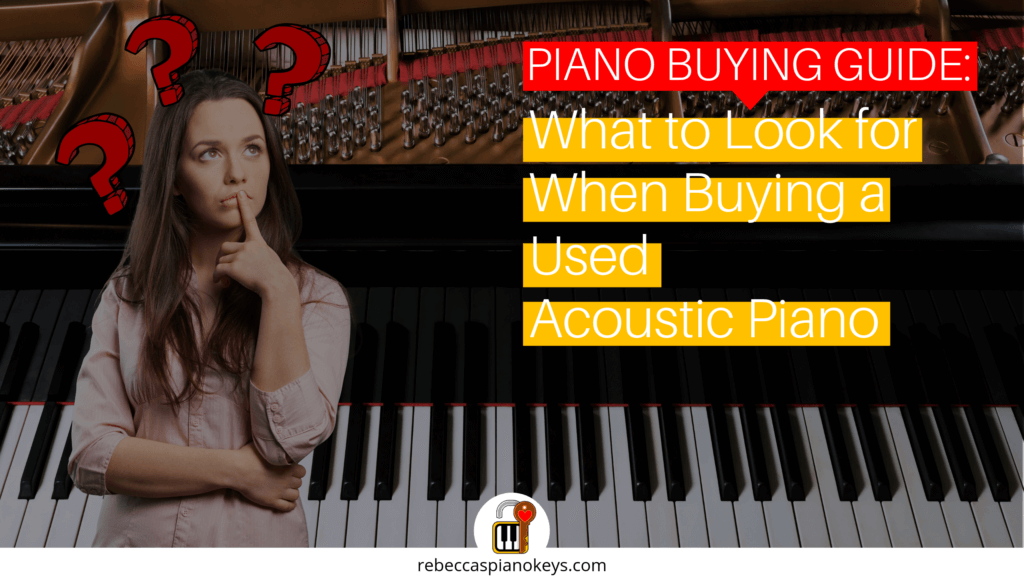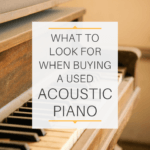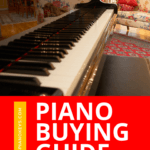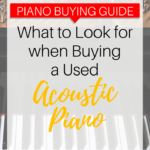Last Updated on May 31, 2022 by Rebecca
This post is part of a 3-part series.
- If you're not sure what type of piano is right for you, this post will help you decide whether you should get an acoustic piano, digital piano, or an electric keyboard.
- If you know you want a digital piano or an electric keyboard, this post will help you understand what all the features mean and which ones will be important to you.
- If you want an acoustic piano and you're looking for tips to help you make sure you buy a good one, you are already in the right place, so keep reading!
So you want to buy an acoustic piano, but you don't know how to make sure you're getting a good one.
Lucky for you, I've got answers for you!
Confession time: I've never actually found myself in a position where I had to buy an acoustic piano!
As a child, I inherited one from my grandmother. It was in excellent condition and was a joy to play on. That piano still lives at my parents' house, so I get to visit it now and then, but sadly, that isn't as often as I'd like.
As an adult, I've purchased 2 digital pianos. I would love to get my hands on an acoustic, but at the moment it's just not in the cards.
So, since I've never actually purchased a used acoustic piano, I had to do a bit of research for this post. (Which means this truly is a win-win blog post, because you get to learn what to look for when buying a used acoustic piano, and this is also information that I'm going to need myself one day!)
In my research, I watched several videos and picked out a few that I thought were the most helpful. I've embedded the videos at the end of this post and I definitely encourage you to watch them yourself so you can get the information demonstrated visually on an actual piano.
But first, I'll give you a written breakdown of the most important information from the videos, in case you prefer learning by reading, or in case you're in a situation where you can't play audio right now.
The experts from the videos are Fred Altenburg from Altenburg Piano House in Elizabeth, New Jersey, and Milo Mills from Northside Piano Company in Lafayette, Indiana. I'll be mentioning Fred and Milo a lot throughout the post!
No time to read now? Pin it for later!

Things to Consider BEFORE You Start Looking for an Acoustic Piano
1) Size
Obviously, you'll want to have an idea of what size of piano you want. As a general rule of thumb, larger pianos are able to produce better quality sound. But you also need to consider what you actually have room for in your home.
Most people are aware of 2 types of acoustic pianos: upright pianos, and grand pianos.
Milo digs a bit deeper and explains 4 types of upright pianos: the spinet piano, the console piano, the studio piano, and the full upright piano. Here's what you need to know about each one:
- Spinet Piano: These are the smallest pianos in terms of height. They were very popular in the 1940s-80s because of their small size, but companies don't make them anymore because it's difficult to make them sound good.
- Console Piano: These are a little taller than spinet pianos and are still quite popular now.
- Studio Piano: These are pianos that are basically designed to be indestructible. They are a bit taller than a console piano and give a bit better sound. There are 2 kinds of studio pianos.
- Institutional studio pianos are commonly used in schools and churches. They often have wheels on them to make them easier to move around.
- Decorator studio pianos are the same height as institutional studio pianos, but they are intended for use in the home so they're not as easy to move around and they're often a bit prettier.
- Full Upright: These are the tallest of the upright pianos, and create the best sound. They came about in the 1880s, then lost popularity in the 1940s when spinets took over. In modern days, the traditional full upright has been replaced by what is called a professional upright, which is a smaller version, but is still considered a full upright. These pianos create a very good sound.
2) Design
This isn't really touched on in the videos (although I think Fred mentions it in passing), but you'll want to consider what you want your piano to look like. What colour do you want? Do you want sleek lines, or intricate carvings?
An acoustic piano isn't like other smaller instruments that can be put away in their case when you aren't using them.
Not by a long shot!
An acoustic piano is a big, hunking piece of furniture in your home! You'll be looking at it all the time. And it will likely also influence your room decor.
So make sure you put a bit of thought into what you want before you start looking.
The BIG Question to Ask Once You Find an Acoustic Piano You Might Like to Buy
When was the piano last tuned?
And you're actually not asking this question for the reason you might expect! Whether or not the piano is currently in tune is actually not all that important to you.
As Milo explains, what you're really finding out is how well the current owners have maintained the piano over the years. A piano that is tuned 1-4 times a year will last longer than a piano that is rarely or infrequently tuned, and will also be in better condition.
It's like shopping for a used car. If you ask when they changed the oil, you don't care if the oil is new right now, what you really want to know is whether current owner has been changing the oil regularly (thereby keeping the car in good condition), or not (leading to unnecessary wear and tear and damage).

What to Look for When You're Inspecting a Specific Upright Piano to Buy
There are 8 things you'll want to check in your pre-buying inspection:
- The Bench
- The Soundboard
- The Pin Blocks
- The Strings
- The Hammers and Dampers
- The Keys
- The Bridges
- Flood Damage
So what exactly are you looking for when you consider each of these 8 components?
1) The Bench
Fred points out that quite often the bench that originally came with the piano mysteriously disappears at some point over the years. So if you find a piano that still has the matching bench (the bench legs match the piano legs), that's a good indicator that the piano has been in a home where it was well maintained.
2) The Soundboard
This is the wood panel behind the strings of the piano. On an upright, it is at the back of the piano; on a grand it is underneath the piano. It amplifies the sound produced by the strings.
Over time, the soundboard can start to crack as the wood shrinks. A cracked soundboard causes a rattling or buzzing sound when you play, which is something you don't want.
Fred says this is not a deal-breaker because it's something that can be fixed by glueing the boards or inserting a shim. Milo, on the other hand, suggests you should think twice before buying a piano with a cracked soundboard because the repairs can be expensive.
3) The Pin Blocks
Milo explains that you can't actually see the pin blocks in an upright piano, but what happens is that as a piano ages, the pin blocks shrink and eventually can no longer hold the pins as tightly as necessary.
When this happens, the loose pin(s) will slip and be unable to maintain the necessary tension to keep the string(s) in tune. When this happens, you can extend the life of the piano by replacing the loose pin with a bigger one, but this is basically just a band-aid fix.
So what you're actually looking for is any pins that look different from the rest (different colour, shinier, newer). If any of the pins have been replaced, that tells you that other pins are likely going to need replacing soon as well. Basically, the piano is on its way out.
4) The Strings
Once again, you're looking for uniformity here. As the strings in a piano age, they become more likely to break during tuning. If a string breaks, you can replace it with a new one.
But the thing is, if one or two strings have broken, that's a good indicator that other strings are going to break soon as well. (It's not like any of them are getting any younger!) So if you see that some of the strings have been replaced, that tells you this piano is running out of time.
5) The Hammers and Dampers
Fred suggests checking for grooves in the felt on the hammers. He says grooves are not necessarily a bad thing. They just mean the piano has been played (which could be a good thing because someone who actually plays their piano is more likely to maintain it properly).
You do, however, want to make sure the grooves don't negatively impact the piano's ability to produce good sound.
You'll also want to check that everything is in general working order.
The videos don't really go into much detail about what “general working order” means, so I'll extrapolate a bit for you. Some things you might want to check include:
- Do the hammers swing nicely?
- When you depress a key, do the dampers move away from the corresponding strings and then return back smoothly when you release the key?
- Does the action move appropriately and uniformly when you press the pedals?
- Does anything look broken?
6) The Keys
Believe it or not, what the keys look like is actually not as important as many of the other items on this list. If some of the keys are stuck or not level, Milo says that's something that can be fixed, usually without breaking the bank.
What you do want to consider when you're looking at the keys is whether they all play.
And the other thing you're looking for is, once again, uniformity (are you noticing a pattern here?). It doesn't matter whether the piano is in or out of tune. What you want is for all the keys to sound equally in or out of tune.
If there are any random keys that are way off compared to the keys beside them, that's indicative of a bigger problem that you may not want to deal with.
7) The Bridges
There are 2 different bridges inside an upright piano: the treble bridge, and the bass bridge. You'll find these inside the bottom of the piano.
What you're looking for here is whether or not there are any cracks where the pins go into the bridge. If the bass bridge is cracked, this is something that can be fixed (although it will cost you!). If the treble bridge is cracked, you're better off just walking away from this piano.
8) Flood Damage
I've been lucky enough never to experience a flood myself. But Fred makes a good point when he says it's something you should check for, especially if you know there have been floods in your area.
Your best bet with a flood damaged piano is just to walk away from it. But how do you know if a piano has been damaged by flooding?
Fred says to check for a water line on the side of the piano, and also check for rust on the strings inside the base of the piano.
What Is the Typical Life-span of an Acoustic Piano?
According to Milo, a well maintained acoustic piano lasts about 50-60 years. So keep this in mind when you're looking at pianos.
FAQ
Now before we get to the videos, I'll share a few thoughts of my own about common questions people often ask.
Should You Buy an Upright Piano or a Grand Piano?
Assuming they are both in equally good condition, a grand piano is just plain better than an upright piano, in my opinion. Due to the simple physics and mechanics of the instruments, a grand piano has several advantages over an upright. (I'll address those more in a future blog post!)
So if you've got the space and budget for a grand, definitely go for it! But if not, an upright piano is still a great instrument.
What Are the Best Brands of Acoustic Pianos?
Honestly, different people have different opinions about this. You have to keep in mind that every piano produces a unique sound. They all have their own personalities to them. Even within a single brand of piano, you'll still find some slight variations.
So, ultimately, the “best” piano is very subjective. Each person will have a different appreciation for the different nuances of each piano.
When choosing the best acoustic piano for you, the best thing you can do is to actually play the pianos you're considering and decide which one you prefer, both in terms of the sound it creates, and how it feels to play.
But if you want a basic starting point, some of the biggest names in acoustic pianos today are Steinway & Sons, Yamaha, and Kawai.
The Videos
Now, if you'd like to see all these piano inspection tips explained visually, with actual pianos for reference, here are the videos I pulled the information from:
The first is by Fred Altenburg, from Altenburg Piano House in Elizabeth, New Jersey.
The second is a series of 3 videos by Milo Mills from Northside Piano Company in Lafayette, Indiana.
These videos are older and lower production quality (posted back in 2011), but the information in them is gold!

Share Your Thoughts!
What do you feel is the most important tip from this post? Have you ever purchased a used acoustic piano? If you have, what was your experience like? Tell us your thoughts/stories in the comments below!
(And if you know someone who would find this post useful, share it with them!)





There is so much to know when buying a piano! I like how you’ve broken it down and made it a step-by-step process though, that’s really helpful for someone like me who has no idea what to look for. Thank you!
I’m glad I was able to help you! I learned a lot myself while researching this post and putting it together! 🙂
Such a great information about piano!
I appreciate your efforts to make this important information available for us. I am going to share this post with one of my friend. She is a piano lover!
Thanks!
Thanks, Vanesh! I’m glad you liked the post, and I hope your friend will as well! 🙂